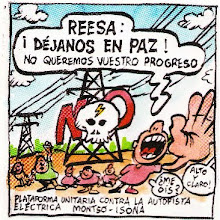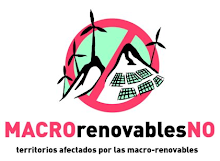Dada su trascendencia (resulta imposible ya alegar que no existen pruebas científicas en torno a los daños que la contaminación electromagnética causa a la salud) la publicamos a continuación en su integridad, lamentando, no disponer aún del texto en castellano o catalán.
Una terrible pregunta queda ahora en el aire: sabiendo lo que hoy sabemos acerca de las afecciones que la Autopista Eléctrica causará a la salud de los habitantes de muchos pueblos, cuya distancia al trazado elegido por Red Eléctrica de España es muy inferior a la que recomiendan los científicos, ¿cómo es posible que pueda llegarse a un consenso sobre el trazado actual de la Peñalba-Monzón-Isona? ¿Ignoran nuestros gobernantes y los responsables de Red Eléctrica que van a poner en riesgo la salud y la vida de un gran número de aragoneses y catalanes o es que los beneficios económicos que van a obtener a costa de nuestro futuro tienen para ellos mayor prioridad que el velar por la salud pública?
A estas alturas ya no sabemos ni qué pensar, pero empieza a parecer que, además del fraude de ley que se está perpetrando con la reelección del trazado de la Graus-Sallente para el nuevo proyecto de Autopista Eléctrica, los ingenieros de REESA y los gobernantes que los apoyan no encuentran el menor inconveniente en poner en riesgo nuestras vidas para sacar adelante una infraestructura que, como llevamos demostrando desde hace tres años, tiene una finalidad meramente especulativa. Ni aunque fuera imprescindible para nuestro desarrollo (y ocurre en realidad todo lo contrario) serían aceptables unos riesgos que ponen en peligro nuestras vidas y las de nuestros hijos; pero dado el caso, empezamos a creer que están dispuestos a acabar físicamente con nosotros por un puñado de monedas.
Torres de alta tensión de la Aragón-Cazaril, que Red Eléctrica de España va a reutilizar para la Autopista Eléctrica Peñalba-Monzón-Isona, en las cercanías de La Puebla del Mon, localidad que quedaría afectada de lleno por el campo electromagnético de esta descomunal línea de alta tensión (400.000 voltios). (Fotografía: Jorge Franco).
De vegades es donen casualitats que fan pensar. Avui, 4 de febrer, Dia Mundial de Lluita contra el Càncer, i just després d'haver conegut la realització d'un estudi, actualment en desenvolupament, sobre la incidència del càncer en el Pallars Jussà, que podria atribuir-se des del nostre punt de vista, com dèiem en l'anterior entrada, a l'enorme quantitat de línies d'alta tensió que ja travessen el seu territori (a la qual ara volen sumar l'Autopista Elèctrica Peñalba-Montsó-Isona i l'augment de capacitat de transport de la línia de Foradada del Toscar a la Pobla de Segur), hem conegut, a través del Karolinska Institutet, la declaració de consens científic al voltant de la urgent necessitat, en pro de la salut pública mundial, de rebaixar els estàndards sobre els camps electromagnètics i la contaminació que se'n deriva, declaració que ahir mateix, 3 de febrer, difonia la International Electro-Magnetic Fields Alliance.
Donada la seva transcendència (és impossible ja al·legar que no existeixen proves científiques al voltant dels danys que la contaminació electromagnètica causa a la salut) la publiquem a continuació en la seva integritat, lamentant, no disposar encara del text en castellà o català.
Una terrible pregunta queda ara en l'aire: sabent el que avui sabem sobre les afeccions que l'Autopista Elèctrica causarà a la salut dels habitants de molts pobles, la distància dels quals al traçat triat per Red Eléctrica de España és molt inferior a la que recomanen els científics, com és possible que pugui arribar-se a un consens sobre el traçat actual de la Peñalba-Montsó-Isona? Ignoren els nostres governants i els responsables de Red Eléctrica que posaran en risc la salut i la vida d'un gran nombre d'aragonesos i catalans o és que els beneficis econòmics que n'obtindran a expenses del nostre futur tenen per a ells més prioritat que vetllar per la salut pública?
A hores d'ara ja no sabem què pensar, però comença a semblar que, a més del frau de llei que s'està perpetrant amb la reelecció del traçat de la Graus-Sallente per al nou projecte de Autopista Elèctrica, els enginyers de REESA i els governants que els donen suport no troben el menor inconvenient a posar en risc les nostres vides per tirar endavant una infraestructura que, com estem demostrant des de fa tres anys, té una finalitat merament especulativa. Encara que fos imprescindible per al nostre desenvolupament (i passa en realitat tot el contrari) serien acceptables uns riscos que posen en perill les nostres vides i les dels nostres fills, però donat el cas, començem a creure que estan disposats a acabar físicament amb nosaltres per un grapat de monedes.
SELETUN STATEMENT
New International EMF Alliance announces scientific Consensus Statement, published today:WORLD HEALTH Urgently Needs Lower EMF Standards, International Scientists Say
Oslo, Norway, February 3, 2011. The International Electromagnetic Fields Alliance (IEMFA) today announces a new published report and scientific Consensus Statement concerning health hazards of electromagnetic fields (EMFs). Led by Olle Johansson, PhD of the Karolinska Institute, the report published by a consortium of international scientists urges global governments to adopt significantly lower human exposure standards for electromagnetic fields. The recommendations are based on the latest body of evidence in biological sciences, and the public-health implications of the unprecedented global exposures to electromagnetic fields from telecommunications and electric power technologies. The scientists recommend specific exposure limits for different frequency fields, including microwaves, used in wireless communications, and ELF electric fields and magnetic fields.According to the international scientists, called the Seletun Scientific Panel, it has become obvious that new, biologically-based public exposure standards are urgently needed to protect long-term public health worldwide. Current public-safety EMF-exposure guidelines used world wide, based on physics models and calculations, currently only protect for damage generated by a heating effect. With respect to prolonged, low-intensity exposures that nowadays frequently occur, but do not have a heating effect, the guidelines, say the scientists, are inadequate and obsolete.The report and Consensus Statement, published in the journal Reviews on Environmental Health http://www.ncbi.nlm.nih.gov/pubmed/21268443 include ten Key Points:1. The global populations are insufficiently protected, thus currently at risk;
2. Sensitive Populations are extra vulnerable;
3. Government actions are urgently warranted now, based on evidence of serious disruption to biological systems;
4. The Burden of Proof for the safety of radiation-emitting technologies should fall on Producers and Providers, not Consumers;
5. EMF Exposures should be reduced in advance of complete understanding of mechanisms of action;
6. The current operative measure of Radiation Risk - the specific absorption rate (SAR) - is inadequate, and misguides on safety and health risks;
7. An international Disease Registry is needed to track Time Trends of the incidence of Illnesses to correlate the illnesses with exposures;
8. Pre-market health testing and safety demonstration is needed for all radiation-emitting technologies;
9. Parity is needed for occupational exposure standards, compared to those for the general public;
10. Persons with Electrohypersensitivity need the classification Functionally Impaired.The International Electromagnetic Fields Alliance has rapidly grown in 2010 into a global collaboration of over fifty health advocacy groups focused on electromagnetic fields (www.iemfa.org). Its principle aim is to disseminate coherent, health-oriented information and advice to the public worldwide on the ever-expanding body of knowledge on biological disruptions observed in living tissues after acute and long-term exposure to non-ionizing electromagnetic fields. The Alliance benefits from the support of a large number of life scientists and medical experts from fifteen countries who collaborate worldwide to address emerging threats to public health.An 18 min. video of Olle Johansson, PhD of the Karolinska Institute, Chair of the scientific panel that issued the report (“The Seletun Scientific Panel”)
Olle Johansson, PhD Announcing Seletun Scientific Statement from ElectromagneticHealth.Org on Vimeo.Transcript of Video Presentation by Olle Johansson, PhD
The Seletun Scientific StatementIntroductionFebruary 3, 2011. The scientific journal Reviews on Environmental Health has published a report by scientists of the International Electromagnetic Fields Alliance (IEMFA) calling for greatly reduced exposure limits for electromagnetic radiation from power line and telecommunications technologies, including cell phones and wireless technologies. The statement, called the Seletun Scientific Statement, was written by seven life scientists in five countries, based on a large and growing body of science showing biological effects.The Seletun Scientific Statement represents a Consensus Agreement among the life scientists including “10 Key Recommendations to Protect Public Health” (see Video of Olle Johansson, PhD of Karolinska Institute, below). The warnings strongly emphasize the global population is at risk, and that there is serious disruption to a number of important biological systems involved.
Transcript text of the Video Presentation
In November 2009, a Scientific Panel comprised of international experts on the biological effects of electromagnetic fields met in Seletun, Norway, for three days of intensive discussion on existing scientific evidence and public health implications of the unprecedented global exposures to artificial electromagnetic fields (EMF) from telecommunications and electric power technologies. This meeting was a direct consequence of on-going discussions already from the mid-90ties, when cellular infrastructure began to rapidly proliferate, and stretching through, among many, the Benevento, Venice and London Resolutions from this decade, and involving important conclusions drawn from the 600-page Bioinitiative Report published August 31, 2007, which was a review of over 2,000 studies showing biological effects from electromagnetic radiation at non-thermal levels of exposure, which partly was published subsequently in the journal Pathophysiology.From all of the above, it has become obvious that new, biologically-based public exposure standards, taking into account long-term as well as non-thermal exposures, are urgently needed to protect public health world-wide.Therefore international scientists gathered in Norway with the objective of developing guidance for global governments on this important emerging public health issue. The Seletun Scientific Panel today announces a Consensus Agreement including 10 Key Recommendations to Protect Public Health. The text below is based on the recent paper published in Reviews on Environmental Health 25 (4), 2010. The original paper can be requested via Olle Johansson, Karolinska Institute, olle.johansson@ki.se.BackgroundEMF exposures (static to 300 GHz) result from the use of electric power and from wireless telecommunications technologies for voice and data transmission, energy, security, military and radar use in weather and transportation.The Seletun Scientific Panel recognizes that the body of evidence on EMF requires a new approach to protection of public health; the growth and development of the fetus, and of children; and argues for strong preventative actions. These conclusions are built upon prior scientific and public health reports documenting the following:1) Low-intensity (non-thermal) bioeffects and adverse health effects are demonstrated at levels significantly below existing exposure standards for telecommunications and power utility technologies in developed and developing countries.2) ICNIRP and IEEE/FCC public safety limits are inadequate and obsolete with respect to prolonged, low-intensity exposures common today.3) New, biologically-based public exposure standards are urgently needed to protect public health world-wide.4) It is not in the public interest to wait. Instead, governments should take decisive action now to protect biological function as well as the health of future generations.Strong concern has been voiced by the public, and by scientists as well as public health and environmental policy experts, that the deployment of technologies that expose billions of people world-wide to new sources of EMF pose a pervasive risk to public health, and may pose a serious risk to future generations. Such exposures did not exist before the “age of industry and information”. A rapidly accumulating body of scientific evidence of harm to health and well-being constitute warnings that adverse health effects can occur with short-term and prolonged exposures to very low-intensity EMF at biologically active frequencies or frequency combinations.The Seletun Scientific Panel has adopted a Consensus Agreement that recommends preventative and precautionary actions that are warranted now, given the existing evidence for potential global health risks. We recognize the duty of governments and their health agencies 1) to educate and warn the public, 2) to implement measures balanced in favor of the Precautionary Principle, 3) to monitor compliance with directives promoting alternatives to wireless, and 4) to fund research and policy development geared toward prevention of exposures and development of new public safety measures as well as new, safer communications technologies.10 Key Points:1. The Global Population Is At Risk. Global populations are not sufficiently protected from electromagnetic fields (EMF) from emerging communication and data transmission technologies that are being deployed worldwide, affecting billions of people;2. Sensitive Populations Are Currently Vulnerable. Sensitive populations (for example, the elderly, the ill, the genetically and/or immunologically challenged) and children and fetuses may be additionally vulnerable to health risks; their exposures are largely involuntary and they are less protected by existing public safety standards; and they may amount to 40-50% of the population;3. Government Actions Are Warranted Now Based on Evidence of Serious Disruption to Biological Systems. The Seletun Scientific Panel urges governments to adopt an explicit statement that “the standard for judging and acting on the scientific evidence shall be based on prudent public health planning principles rather than scientific certainty of effect (causal evidence)”. Actions are warranted based on limited, or weak, scientific evidence, or a sufficiency of evidence – rather than a conclusive scientific evidence (causation or scientific certainty) where the consequence of doing nothing in the short term may cause irreparable public health and economic harm, where the populations potentially at risk are very large, where there are alternatives without similar risks, or where the exposures are largely involuntary;4. The Burden of Proof for the Safety of Radiation-Emitting Technologies Should Fall on Producers and Providers Not Consumers. The Seletun Scientific Panel urges governments to make explicit that the burden of proof of safety rests with the producers and providers of EMF- producing technologies, not with the users and consumers.5. EMF Exposures Should Be Reduced in Advance of Complete Understanding of Mechanisms of Action. EMF exposures should be reduced now rather than waiting for proof or understanding of mechanisms of harm before acting. This recommendation is in keeping with traditional public health principles, and is justified now given abundant evidence that biological effects and adverse health effects are occurring at exposure levels many orders of magnitude below existing public safety standards around the world;6. The Current Accepted Measure of Radiation Risk—the Specific Absorption Rate (‘SAR’)—Is Inadequate, and Misguides on Safety and Risk. SAR is not an adequate approach to predict many important biologic effects in studies that report increased risks for cancer, neurological diseases, impairments to immune function, fertility and reproduction, and neurological function (cognition, behaviour, performance, mood status, disruption of sleep, increased risk for auto collisions, etc);7. An International Disease Registry Is Needed To Track Time Trends of Illnesses to Correlate Illnesses with Exposures. The Seletun Scientific Panel recommends an international registry be established to track time-trends in incidence and mortality for cancers and neurological and immune diseases. Tracking effects of EMF on children and sensitive EHS populations is a high priority. There should be open access to this information;8. Pre-Market Health Testing and Safety Demonstration of All Radiation-Emitting Technologies. There is a need for mandatory pre-market assessments of emissions and risks before deployment of new wireless technologies. There should be convincing evidence that products do not cause health harm before marketing;9. Parity Needed for Occupational Exposure Standards. The Panel discourages use of more lenient public safety standards for workers, as compared to the general public. Separate safety limits are not ethically acceptable. Workers include women of childbearing age and men who wish to retain their fertility;10. Functional Impairment Designation for Persons with Electrohypersensitivity. The Panel strongly recommends that persons with electrohypersensitivity symptoms (EHS) be classified as functionally impaired rather than with ‘idiopathic environmental disease’ or similar indistinct categories. This terminology accepts responsibility for the environmental cause of the related health challenges and will encourage governments to make adjustments in the living environment to better address social and well-being needs of this subpopulation of highly sensitive members of society.New Recommended Exposure Standards
The Seletun Panel recommends global governments adopt the following exposure guidelines to protect public health and the health of future generationsExtremely Low Frequency Fields:• Exposure Limit Recommended. Based on the available evidence, the Seletun Scientific Panel recommends a 0.1 uT (1 mG) exposure limit for extremely low frequency (fields from electrical power) for all new installations, such as powerlines, indoor electric appliances, house-hold items, TVs, radios, computers, and telecommunication devices, based on findings of risk for leukemia, brain tumours, Alzheimer’s, ALS, sperm damage and DNA strand breaks. This exposure limit does not include a safety margin, but starts right at the level where hazardous effects are found. The new recommendation is approx. 1,000 – 10,000 times lower than the current ICNIRP/IEEE standards;• Set-Back Distance. For all newly installed, or newly upgraded electrical power distribution, the Panel recommends a 0.1 uT (1 mG) set-back distance, from residences, hospitals, schools, parks, and playgrounds schools (and similar locations occupied by children) ; this set-back distance easily can amount to 50 meters or more;• Maximum 24-Hour Exposure Limit. For all newly constructed residences, offices, schools (and other facilities with children), and hospitals there shall be a 0.1 uT (1 mG) max. 24 hour average exposure limit;Radiofrequency and Microwave Radiation:Regarding radiofrequency/microwave radiation, the present guidelines, such as IEEE, FCC, and ICNIRP, are not adequate to protect humans from harmful effects of chronic EMF exposure. It is now instead recommended that:• For whole-body (in vivo experiments) or cell culture-based exposure, 33 µW//kg. It is approx. 2,400 times lower than the current ICNIRP/FCC standards. No further safety margin or provision for sensitive populations, such as immune-compromised patients or persons with the functional impairment electrohypersensitivity, is incorporated. This may need to be lowered in the future.• Based on power density measurements, IEMFA’s Seletun Scientific Panel finds sufficient evidence for a whole-body scientific benchmark for adverse health effect exists down to 0.17 mW/m2 (also 0.000017 mW/cm2 = 0.017 µW/cm2). It is approx. 50,000 – 60,000 times lower than the current ICNIRP/FCC standards.This may need to be lowered in the future.• The Seletun Scientific Panel acknowledges that numeric limits derived here for new biologically-based public exposure standards are still a billion times higher than natural EMF levels at which all life evolved. It is a serious mistake to believe that we have always lived in man-made electromagnetic fields, such as from electrical power, radio, TV, computers, and wireless telecommunication, and therefore should not worry. It was not long ago when people thought that X-rays, radioactivity, strong ultraviolet light and radar were completely without harm. Nowadays we know much better!____________________The Seletun Scientific Panel is comprised of 7 scientists from 5 countries, including Olle Johansson, PhD, Karolinska Institute, Chair, Adamantia Fragopoulou, Yuri Grigoriev, Lukas Margaritas, Lloyd Morgan, Elihu Richter, and Cindy Sage.
Links:
Read the summary on PubMed: http://www.ncbi.nlm.nih.gov/pubmed/21268443
To read the full recommendations of IEMFA's Scientific Seletun Panel, please go to: http://iemfa.org/index.php/publications/seletun-resol















































































No hay comentarios:
Publicar un comentario